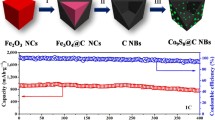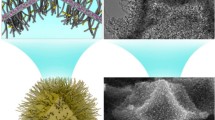Abstract
The shuttle effect of lithium polysulfides and the uncontrollable deposition of lithium sulfides (Li2S) severely hinder the realization of high-performance lithium-sulfur (Li-S) batteries. Herein, we fabricated a carbon cloth (CC)-based self-supported interlayer (denoted as Co4S3/C@CC), which is covered with Co4S3-embedded porous carbon nanoarrays through a facile two-step method with cobalt-based metal-organic framework (Co-MOF) nanosheets as the template. The interconnected carbon network and the polar Co4S3 nanoparticles in the Co4S3/C@CC interlayer not only effectively suppress the polysulfide shuttle, but also significantly facilitate the lithium ion (Li+) conduction with a considerable Li+ transference number of 0.86. Besides, the rich interfaces between the polar Co4S3 nanoparticles and the conductive carbon substrate serve as reaction sites to accelerate the polysulfide conversion and guide the flower-like growth of Li2S, which ultimately mitigates the interlayer surface passivation and improves the sulfur utilization. Therefore, the Li-S batteries with the Co4S3/C@CC interlayer deliver an excellent rate capacity (368.7 mA h g−1 at 10 C), a stable cycling performance (a low fading rate of 0.045% per cycle over 1400 cycles at 2.0 C), and a high initial areal capacity (4.83 mA h cm−2 at 0.2 C under a sulfur loading of 4.6 mg cm−2). This work provides a perspective on the self-supported catalytic interlayer for the selective Li+ conduction and Li2S regulation toward high-performance Li-S batteries.
摘要
多硫化锂的飞梭效应与不可控硫化锂(Li2S)的沉积现象严重阻碍了高性能锂硫电池的实现. 在本研究中, 我们制备了一种负载有Co4S3/C多孔纳米阵列的自支撑碳布(CC)基夹层(Co4S3/C@CC), 其中Co4S3/C多孔纳米阵列是以钴基金属-有机框架(Co-MOF)纳米片为模板制备而成的. Co4S3/C@CC夹层中相互连接的碳网络和极性Co4S3纳米粒子不仅能有效地抑制多硫化物飞梭, 而且能显著地促进锂离子(Li+)的传导,其Li+迁移数高达0.86. 此外, 极性Co4S3纳米粒子与导电碳基底之间丰富的界面能够作为反应中心以加速多硫化物的转化与引导Li2S的花状生长, 最终减轻Li2S对夹层表面的钝化以及提高硫的利用率. 因此, 载有Co4S3/C@CC夹层的锂硫电池可以提供出色的倍率容量(在10 C时比容量为368.7 mA h g−1)、稳定的循环性能(在2.0 C下1400周循环过程中衰减率为0.045%)以及高初始面容量(在0.2 C且硫含量为4.6 mg cm−2时面容量达到4.83 mA h cm−2). 这项工作展现了自支撑催化夹层对高性能锂硫电池中选择性Li+传导和Li2S沉积的调控能力.
Similar content being viewed by others
References
Choi JW, Aurbach D. Promise and reality of post-lithium-ion batteries with high energy densities. Nat Rev Mater, 2016, 1: 16013
Bruce PG, Freunberger SA, Hardwick LJ, et al. Li-O2 and Li-S batteries with high energy storage. Nat Mater, 2012, 11: 19–29
Zhang SS. Liquid electrolyte lithium/sulfur battery: Fundamental chemistry, problems, and solutions. J Power Sources, 2013, 231: 153–162
Bonnick P, Muldoon J. The Dr Jekyll and Mr Hyde of lithium sulfur batteries. Energy Environ Sci, 2020, 13: 4808–4833
Liu T, Hu H, Ding X, et al. 12 years roadmap of the sulfur cathode for lithium sulfur batteries (2009-2020). Energy Storage Mater, 2020, 30: 346–366
Yuan H, Chen X, Zhou G, et al. Efficient activation of Li2S by transition metal phosphides nanoparticles for highly stable lithium-sulfur batteries. ACS Energy Lett, 2017, 2: 1711–1719
Yuan C, Yang X, Zeng P, et al. Recent progress of functional separators with catalytic effects for high-performance lithium-sulfur batteries. Nano Energy, 2021, 84: 105928
Fan L, Li M, Li X, et al. Interlayer material selection for lithium-sulfur batteries. Joule, 2019, 3: 361–386
Yuan H, Liu T, Liu Y, et al. A review of biomass materials for advanced lithium-sulfur batteries. Chem Sci, 2019, 10: 7484–7495
Su YS, Manthiram A. A new approach to improve cycle performance of rechargeable lithium-sulfur batteries by inserting a free-standing MWCNT interlayer. Chem Commun, 2012, 48: 8817–8819
Park J, Yu BC, Park JS, et al. Tungsten disulfide catalysts supported on a carbon cloth interlayer for high performance Li-S battery. Adv Energy Mater, 2017, 7: 1602567
Wang X, Zhao Y, Wu F, et al. ZIF-7@carbon composites as multifunctional interlayer for rapid and durable Li-S performance. J Energy Chem, 2021, 57: 19–27
Zhao M, Peng HJ, Wei JY, et al. Dictating high-capacity lithium-sulfur batteries through redox-mediated lithium sulfide growth. Small Methods, 2020, 4: 1900344
Dong Y, Shi W, Lu P, et al. 2D holey cobalt sulfide nanosheets derived from metal-organic frameworks for high-rate sodium ion batteries with superior cyclability. J Mater Chem A, 2018, 6: 14324–14329
Xie Y, Yin J, Zheng J, et al. Synergistic cobalt sulfide/eggshell membrane carbon electrode. ACS Appl Mater Interfaces, 2019, 11: 32244–32250
Liu Y, Luo X, Zhou C, et al. A modulated electronic state strategy designed to integrate active HER and OER components as hybrid heterostructures for efficient overall water splitting. Appl Catal B-Environ, 2020, 260: 118197
Shi M, Wang Q, Hao J, et al. MOF-derived hollow Co4S3/C nanosheet arrays grown on carbon cloth as the anode for high-performance Li-ion batteries. Dalton Trans, 2020, 49: 14115–14122
Liu S, Xia X, Yao Z, et al. Straw-brick-like carbon fiber cloth/lithium composite electrode as an advanced lithium metal anode. Small Methods, 2018, 2: 1800035
Li X, Yang X, Ye J, et al. A trifunctional modified separator based on Fe tetraaminophthalocyanine@rGO for lithium-sulfur batteries. Chem Eng J, 2021, 405: 126947
Fang Y, Cai W, Zhu S, et al. Vesicle-shaped ZIF-8 shell shielded in 3D carbon cloth for uniform nucleation and growth towards long-life lithium metal anode. J Energy Chem, 2021, 54: 105–110
Wang Z, Shen J, Liu J, et al. Self-supported and flexible sulfur cathode enabled via synergistic confinement for high-energy-density lithium-sulfur batteries. Adv Mater, 2019, 31: 1902228
Yang JL, Zhao SX, Lu YM, et al. ZnS spheres wrapped by an ultrathin wrinkled carbon film as a multifunctional interlayer for long-life Li-S batteries. J Mater Chem A, 2020, 8: 231–241
Liu J, Qiao Z, Xie Q, et al. Phosphorus-doped metalorganic framework-derived CoS2 nanoboxes with improved adsorption-catalysis effect for Li-S batteries. ACS Appl Mater Interfaces, 2021, 13: 15226–15236
Zhang H, Tian D, Zhao Z, et al. Cobalt nitride nanoparticles embedded in porous carbon nanosheet arrays propelling polysulfides conversion for highly stable lithium-sulfur batteries. Energy Storage Mater, 2019, 21: 210–218
Liu P, Zhu C, Gao S, et al. N-doped porous carbon nanoplates embedded with CoS2 vertically anchored on carbon cloths for flexible and ultrahigh microwave absorption. Curr Alzheimer Resbon, 2020, 163: 348–359
Peng HJ, Hou TZ, Zhang Q, et al. Strongly coupled interfaces between a heterogeneous carbon host and a sulfur-containing guest for highly stable lithium-sulfur batteries: Mechanistic insight into capacity degradation. Adv Mater Interfaces, 2014, 1: 1400227
Qiu Y, Li W, Zhao W, et al. High-rate, ultralong cycle-life lithium/sulfur batteries enabled by nitrogen-doped graphene. Nano Lett, 2014, 14: 4821–4827
Kaneti YV, Zhang J, He YB, et al. Fabrication of an MOF-derived heteroatom-doped Co/CoO/carbon hybrid with superior sodium storage performance for sodium-ion batteries. J Mater Chem A, 2017, 5: 15356–15366
Khan AA, Kumari S, Chowdhury A, et al. Phase tuned originated dual properties of cobalt sulfide nanostructures as photocatalyst and adsorbent for removal of dye pollutants. ACS Appl Nano Mater, 2018, 1: 3474–3485
Zhong Y, Yin L, He P, et al. Surface chemistry in cobalt phosphide-stabilized lithium-sulfur batteries. J Am Chem Soc, 2018, 140: 1455–1459
Zhou G, Tian H, Jin Y, et al. Catalytic oxidation of Li2S on the surface of metal sulfides for Li-S batteries. Proc Natl Acad Sci USA, 2017, 114: 840–845
Li BQ, Kong L, Zhao CX, et al. Expediting redox kinetics of sulfur species by atomic-scale electrocatalysts in lithium-sulfur batteries. InfoMat, 2019, 1: 533–541
Zhao M, Li BQ, Chen X, et al. Redox comediation with organopolysulfides in working lithium-sulfur batteries. Chem, 2020, 6: 3297–3311
Fan FY, Chiang YM. Electrodeposition kinetics in Li-S batteries: Effects of low electrolyte/sulfur ratios and deposition surface composition. J Electrochem Soc, 2017, 164: 917–922
Li Z, Zhou Y, Wang Y, et al. Solvent-mediated Li2S electrodeposition: A critical manipulator in lithium-sulfur batteries. Adv Energy Mater, 2019, 9: 1802207
Ghazi ZA, He X, Khattak AM, et al. MoS2/celgard separator as efficient polysulfide barrier for long-life lithium-sulfur batteries. Adv Mater, 2017, 29: 1606817
Su Z, Tong CJ, He DQ, et al. Ultra-small B2O3 nanocrystals grown in situ on highly porous carbon microtubes for lithium-iodine and lithium-sulfur batteries. J Mater Chem A, 2016, 4: 8541–8547
Kim J, Lee DJ, Jung HG, et al. An advanced lithium-sulfur battery. Adv Funct Mater, 2013, 23: 1076–1080
Cao Y, Wu H, Li G, et al. Ion selective covalent organic framework enabling enhanced electrochemical performance of lithium-sulfur batteries. Nano Lett, 2021, 21: 2997–3006
Xu K, Zhu M, Zhu L, et al. Promoting spherical epitaxial deposition of solid sulfides for high-capacity Li-S batteries. J Mater Chem A, 2020, 8: 7100–7108
Chu H, Noh H, Kim YJ, et al. Achieving three-dimensional lithium sulfide growth in lithium-sulfur batteries using high-donor-number anions. Nat Commun, 2019, 10: 188
Qi C, Li Z, Sun C, et al. Cobalt phosphide nanoflake-induced flower-like sulfur for high redox kinetics and fast ion transfer in lithium-sulfur batteries. ACS Appl Mater Interfaces, 2020, 12: 49626–49635
Pan H, Chen J, Cao R, et al. Non-encapsulation approach for highperformance Li-S batteries through controlled nucleation and growth. Nat Energy, 2017, 2: 813–820
Peng HJ, Huang JQ, Cheng XB, et al. Review on high-loading and high-energy lithium-sulfur batteries. Adv Energy Mater, 2017, 7: 1700260
Liu M, Li Q, Qin X, et al. Suppressing self-discharge and shuttle effect of lithium-sulfur batteries with V2O5-decorated carbon nanofiber interlayer. Small, 2017, 13: 1602539
Acknowledgements
This work was financially supported by the National Natural Science Foundation of China (51871188 and 51931006).
Author information
Authors and Affiliations
Contributions
Author contributions Xie RJ, Peng DL, and Liu J conceived and designed the project, wrote and revised the paper; Liu J was primarily responsible for the experiments; Song Y and Lin C helped perform the experiments; Xie Q provided the useful suggestions. All authors contributed to the general discussion.
Corresponding authors
Ethics declarations
Conflict of interest The authors declare that they have no conflict of interest.
Additional information
Supplementary information Supporting data are available in the online version of the paper
Jianbin Liu is currently a PhD student at the College of Materials, Xiamen University. He received his BS degree at the School of Materials Science and Engineering, Fuzhou University in 2016. His research interests focus on the luminescent MOF materials and MOF-derived nanostructured energy materials.
Dong-Liang Peng received his PhD degree in condensed matter physics, Lanzhou University in 1997. He received another PhD degree at the Department of Materials Science and Engineering, Nagoya Institute of Technology (Japan) in 2002. Now, he is a professor at the College of Materials, Xiamen University. His research focuses on the nanostructured materials, and their applications in electromagnetics and energy storage and conversion.
Rong-Jun Xie received his PhD degree from Shanghai Institute of Ceramics, Chinese Academy of Sciences in 1998. He worked for the National Institute for Materials Science in Japan as a senior researcher (2003–2007), principal researcher (2007–2014), and chief researcher (2014–2018). Since then, he has been a full professor at the College of Materials, Xiamen University. His research focuses on the designing and developing of luminescent materials for solid state lighting and displays.
Supplementary information
40843_2021_1815_MOESM1_ESM.docx
Regulating Li+ migration and Li2S deposition by metal-organic framework-derived Co4S3-embedded carbon nanoarrays for durable lithium-sulfur batteries
Rights and permissions
About this article
Cite this article
Liu, J., Song, Y., Lin, C. et al. Regulating Li+ migration and Li2S deposition by metal-organic framework-derived Co4S3-embedded carbon nanoarrays for durable lithium-sulfur batteries. Sci. China Mater. 65, 947–957 (2022). https://doi.org/10.1007/s40843-021-1815-2
Received:
Accepted:
Published:
Issue Date:
DOI: https://doi.org/10.1007/s40843-021-1815-2




